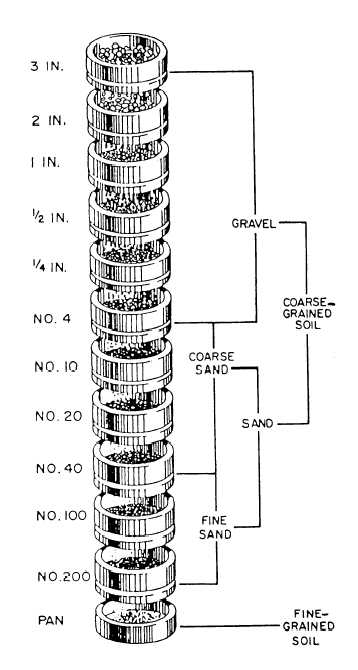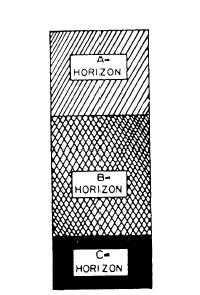Figure 15-58.—Soil profile.
Soil Classification
The soils you normally work with in earthwork
operations are classified as follows:
. Coarse grained
. Fine grained
l Organic
COARSE-GRAINED SOILS.— Soils in this
classification are composed of sand and gravel and are
in the B-horizon. Coarse-grained soils have 50 percent
or less material passing the No. 200 sieve. Their grain
shape varies from rounded to angular and has good
load-bearing qualities and drains freely.
FINE-GRAINED SOILS.— Fine-grained soils
are composed of silt and clay and are in the B-horizon.
They have 50 percent or more material passing the No.
200 sieve. Fine-grained soils have good-load bearing
qualities when dry; however, these soils drain poorly,
and when wet, have little or no load-bearing strength.
This characteristic is especially true with clay.
ORGANIC SOILS.— Organic soils, sometimes
referred as top soil, are composed mostly of decayed
plant and animal matter and are in the A-horizon.
These soils retain moisture, are difficult to compact,
and are normally used when landscaping a finish
project.
Soil Sizes
Soils are grouped by the size of their particle
grains. One method used to distinguish sizes is
through the use of sieves (fig. 15-59). A sieve is a
screen attached across the end of a cylindrical metal
frame. The screen allows particles smaller than its
openings to fall through and retains larger particles.
Sieves with screen openings of different sizes allows
you to sort soil into particle groups, based on size.
Sieve sizes are designated by the screen opening
size; for example, a 3-inch sieve has a screen with
openings 3 inches square. A No. 4 sieve has four
openings per linear inch, thus having 16 openings per
square inch.
Figure 15-59.—Standard sieve set.
15-35




